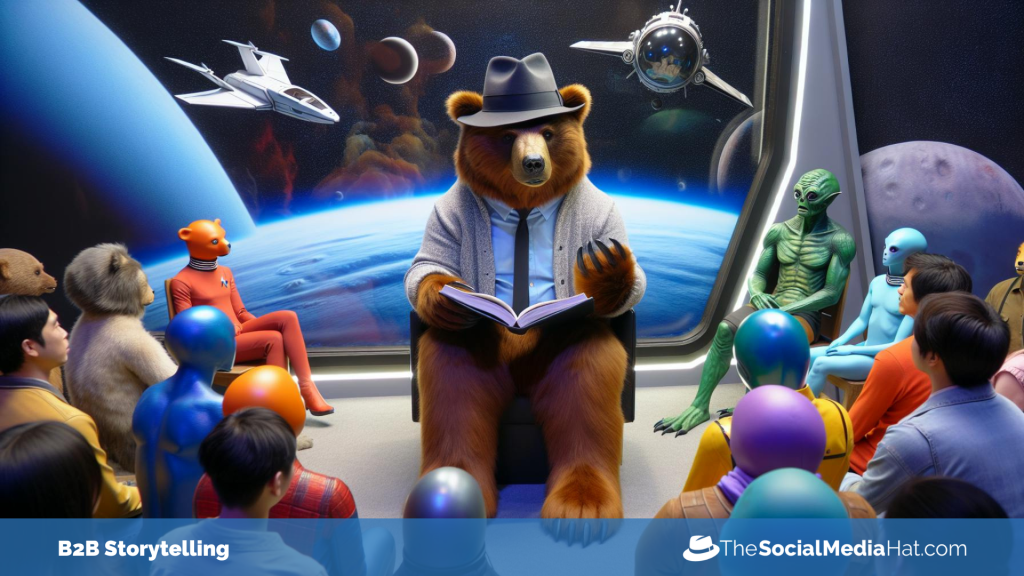In the busy B2B marketing landscape, making your brand stand out goes beyond offering a distinct value proposition and a strong content marketing plan. The elements of storytelling transform how companies interact with their audiences, nurture potential clients and boost conversions. By sharing stories that touch the heart, businesses can build a closer bond with their customers. Storytelling emerges as a crucial strategy for marketers aiming to make an impact.
Grasping Storytelling’s Impact in B2B Marketing
B2B storytelling revolves around crafting and distributing stories that reflect your brand’s ethos, mission and solutions in an engaging manner. It’s all about converting complex concepts into narratives that your target audience can relate to and connect with on a personal level. Unlike B2C marketing, where impulsive purchases are more common, B2B marketing transactions are calculated and planned. This underscores the importance of an authentic brand voice and supportive content that assists customers on their journey, making storytelling essential for fostering lasting relationships.
The power of storytelling in B2B marketing lies in its ability to humanize your brand and create a deeper connection with your audience. By sharing real-life examples, use of influencers, case studies and success stories, you demonstrate how your products or services have positively impacted your clients’ businesses. This not only builds trust and credibility, but also makes your brand more relatable and memorable. When prospects can see themselves in the stories you tell, they are more likely to engage with your content and consider your solutions, thus establishing an emotional connection.
Moreover, storytelling helps to differentiate your brand in a crowded market. By sharing unique stories that highlight your brand’s personality, values and expertise, you can set yourself apart from competitors and create a memorable brand identity. This is particularly important in the B2B space, where products and services can often be similar, and differentiation is key to winning business.
Crucial Elements for Engaging B2B Narratives
For your stories to captivate and convert into sales, a few critical factors must align. Understanding your audience is key. Creating detailed buyer personas gives you a clear picture of their needs, obstacles and how they make decisions. Armed with this knowledge, you can weave conversion-focused narratives that speak directly to their searches for solutions. Incorporating storytelling into your content strategy ensures that every blog, video or case study adds to a unified narrative, guiding prospects closer to making a purchase.
To craft compelling B2B narratives, it’s essential to focus on the challenges that your audience face and how your brand can help overcome them. Use storytelling techniques such as character development, customer journey storytelling, as well as conflict and resolution stories to create a narrative arc that resonates with your target audience. By highlighting the pain points and aspirations of your buyer personas, you can create stories that not only inform potential customers, but also inspire and motivate them to take action. Remember, the goal is to position your brand as the guide that helps your customers navigate their challenges and achieve their goals.
Embedding Authenticity and Emotional Connections
The foundation of striking B2B narratives is authenticity. In today’s savvy market, customers can easily spot the difference between genuine messaging and promotional fluff. Hence, it’s vital to share true stories that epitomize what your brand stands for. Equally crucial is establishing an emotional bond. Despite the logical and data-heavy nature of B2B transactions, remember, real people make these decisions, and their emotions play a significant role. What others say about you as well as the narratives that stimulate empathy or ignite excitement can dramatically boost the appeal of your marketing efforts to your target demographic.
Authenticity in B2B storytelling also means being transparent about your brand’s journey, including the challenges you’ve faced and the lessons you’ve learned along the way. By sharing your own story, you create a sense of vulnerability and relatability that can foster stronger emotional connections with your audience. Try doing this on LinkedIn with your B2B content marketing and see what happens.
Additionally, using customer testimonials and user-generated content can add an extra layer of authenticity to your narratives, as they provide social proof and demonstrate the real-world impact of your solutions.
Storytelling Through the Customer Journey
The B2B buying process is intricate, involving various stages and decision-makers. Against this background, effective storytelling should narrate tailored stories at each stage of the journey. From the initial discovery to consideration and the final decision, your content should build upon the story, emphasizing your brand’s unique offerings and a deep comprehension of the audience’s issues and requirements. This careful crafting guarantees that every content piece moves potential clients towards making a decision, using lead nurturing strategies to keep future buyers engaged and to propel them forward.
To sum up, storytelling in B2B isn’t just a passing fad in content marketing, but a cornerstone of an impactful content marketing strategy. By focusing on stories that relate to both the customer journey and that evoke emotional responses, companies can engage their audiences authentically and push towards higher conversions. In the B2B sector, where buying cycles are lengthier and involve more complexity, a persuasive, genuine narrative can significantly aid in maintaining lead interest and meeting your marketing goals.
Related Resourcs for SMB Owners & Marketers










